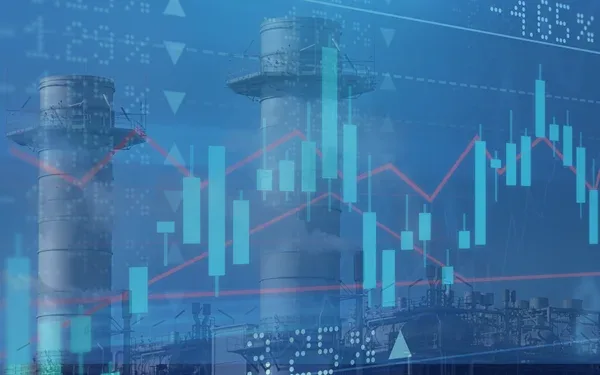EDAM gains more momentum at recent Las Vegas forum
On August 30, about 240 people from across the West attended the California Independent System Operator’s (ISO) Extended Day-Ahead Market (EDAM) Forum in Las Vegas – with another 300 participating remotely – highlighted by an announcement that the Balancing Authority of Northern California (BANC) intends to join the market in the spring of 2026.
“We have concluded that participation in EDAM provides the best benefit for BANC and its WEIM (Western Energy Imbalance Market) participants while leveraging the investment we have made – and preserving the benefits we see – in WEIM,” Jim Shetler, BANC’s general manager, said in a news release announcing the decision.
“BANC looks forward to joining PacifiCorp and others to drive further economic, environmental, and operational benefits for the (WEIM) footprint through the EDAM.” Last December, PacifiCorp became the first energy provider to announce its intention to join EDAM.

Shetler also announced at the Forum that BANC’s largest member, the Sacramento Municipal Utility District (SMUD), has decided it intends to join the EDAM.
“Not only is the EDAM an important tool to support reliability and resiliency and low rates while helping SMUD deliver on our industry-leading decarbonization goals, it will also provide broader price, reliability and decarbonization benefits in support of regional goals,” Paul Lau, CEO and General Manager of SMUD, said in the BANC news release.
The BANC and SMUD announcements came during a CEO roundtable at the start of an all-day gathering that featured a diverse array of utility executives, regulators, stakeholders and other Western energy leaders discussing the benefits of a broad Western electricity market, progress made thus far and the work underway regarding resource adequacy, governance and other issues that are key to successful regional market integration.
BANC was a co-sponsor of the Forum, along with the California ISO, NV Energy, PacifiCorp and Southern California Edison.
In addition to the CEO roundtable, Forum participants also heard panel discussions on how regulators and stakeholders view evolving markets in the West, a study showing the potential economic benefits of an extended-day-ahead market and important progress on ensuring interoperability between EDAM and the various resource adequacy programs in the West.
Working extensively with stakeholders over the past two years, the EDAM was designed to build on the success of WEIM, which, since its launch by the ISO and PacifiCorp in late 2014, has grown to include 22 participants in 12 states. As of June 30, 2023, WEIM participants have realized more than $4.2 billion in cumulative benefits, something several utility CEOs at the Forum said translates directly into savings for ratepayers.
“That’s definitely top of mind to our customers when they’re facing higher escalation in power costs because of fuel and commodity costs that are rising,” Stefan Bird, president of Pacific Power, a division of PacifiCorp, said.
Potential financial benefits of an extended day-ahead market were the focus of an hour-long presentation by John Tsoukalis, a principal of the Brattle Group, an international firm that consults on a wide range of economic, finance and regulatory issues. Brattle used the ISO Board-approved EDAM design to model its analysis of EDAM’s potential benefits in a study underwritten by BANC, Idaho Power, the Los Angeles Department of Water and Power and PacifiCorp.
Tsoukalis said the purpose of his analysis, which concluded that EDAM participants would realize $430 million in net benefits by 2032, was to help potential market participants decide if they would benefit from joining EDAM.

“The reason we see benefits,” Tsoukalis said, “is because the more efficient use of transmission and more efficient day-ahead scheduling you get under EDAM means 2 1/2 terawatt hours of mostly solar energy that’s no longer curtailed . . . That’s the main driver of the benefits right there. In some ways, that’s the whole headline of the story.” A terawatt-hour is enough energy to fully power about 70,000 homes.
The WEIM, a real-time market that includes only a fraction of the energy transactions that occur in the region because they take place close to when the energy is being used, has also improved reliability by making it easier for participants to share electricity where and when it’s needed.
WEIM participants have also seen reduced greenhouse gas emissions because, with more variable resources such as solar and wind on the grid, excess clean power would typically tend to be curtailed and go unused to keep the system from becoming overloaded. With greater regional coordination, that clean power can be moved across a broad geographic area to displace other resources. EDAM, which would cover the more extensive day-ahead market that enables more advanced planning, would produce greater benefits over a larger geographic footprint.
Virtually all of the participants in the Forum’s panel presentations acknowledged that the West benefits from greater coordination, planning and sharing of energy resources.
“All of us inherently understand sharing is good, sharing has benefits,” Greg Patterson, director of the Arizona Competitive Power Alliance, said during a panel featuring a variety of stakeholder perspectives. “It allows you to use resources that you are not using and apply them to whatever it is you are doing. We’ve got an ability to share, we can have an economic incentive to share, and because of that we need less resources. I think that’s what the whole day has been about.”
During the panel discussion featuring utility regulators from several Western states, there was also a discussion of how the markets could evolve to better share resources, optimize transmission, enhance reliability and provide cost savings for ratepayers. These important elements of the electric system are characteristics that all states have in common, they noted in an upbeat conversation indicative of the positive mood throughout the day, and they are interested in exploring the opportunities further together.
As part of that effort, nine Western regulators released a letter in mid-July calling for “creation of the entity that could serve as a means for delivering a market that includes all states in the Western Interconnection, including California, with independent governance.”
“We’re recognizing the benefit of a large West-wide market,” Alice Reynolds, president of the California Public Utilities Commission and a signatory to the letter, said. “A market with a big footprint, a market where we could share resources, where we can optimize transmission and the opportunity to build on investments our ratepayers have already made.”

Reynolds went on to say that while the governance issue is being explored, it is important to simultaneously work on “how we can build this so there’s an entity to provide the full range of options for regional cooperation, recognizing that we may not ultimately use all of them.”
Participating regulators are now asking any interested stakeholders to provide their comments on a series of questions that can help them best organize their effort and ensure effective stakeholder engagement.
The panel on EDAM and resource adequacy explored efforts underway in California and the broader region through the Western Power Pool’s nascent Western Resource Adequacy Program (WRAP) to make sure there is enough power under contract to meet growing demand and the challenges of an evolving resource mix.
While the California program and WRAP differ in their approach to resource adequacy, panel members and moderator Mark Rothleder, the ISO’s senior vice president and chief operating officer, indicated that through collaborative engagement a pathway to good interoperability between the programs has been achieved. There has also been excellent progress made in ensuring interoperability between WRAP and EDAM and honoring the rights of individual transmission contract holders.
“What a lot of folks don’t realize is the number of hours and meetings that went into arriving at this spot,” noted Mike Wilding, vice president of energy supply management for PacifiCorp, which has said it intends to join EDAM and is also part of the WRAP.
That collaborative engagement on resource adequacy was underscored by panelist Sarah Edmonds, president and CEO of the Western Power Pool, who said, “We’re trying to optimize the value proposition of both programs” so they complement each other and enhance reliability throughout the West.
The market design of EDAM has recognized this need and developed a universal adapter, a daily resource sufficiency evaluation as an approach for bringing different resource adequacy and integrated resource planning programs together into a common day-ahead market.
ISO President and CEO Elliot Mainzer also made a point about the importance of making sure resource adequacy is optimized and coordinated as much as possible.
“No market is actually a substitute for a solid foundation of resource adequacy,” he said. “RA, that’s the bottom foundation layer. And that’s why it’s so important for all of us to be taking those steps to get to solid resource adequacy to meet those planning standards. The market really is an optimization tool.”
Overall, particularly with the ISO’s recent filing of proposed EDAM tariff provisions with the Federal Energy Regulatory Commission, and with the BANC and SMUD announcements, there was a strong sense during the Forum of urgency and positive momentum toward enhanced regional coordination and collaboration.
“It was wonderful to be with so many energy leaders from across the West who understand that we enhance our ability to serve the public when we work together to share resources, plan infrastructure and coordinate operations to help ensure reliability as we continue transitioning to a clean, reliable and equitable power system,” Mainzer said when the event was over.
“A lot of outstanding work has been done so far and we all know there is more to do regarding governance and other concerns. But I am confident that with this level of participation and commitment from so many stakeholders and energy leaders, we can build an extended day-ahead market that works for everyone.”
A recording of the EDAM Forum, the agenda, speaker biographies and presentations that were made can be found here.


